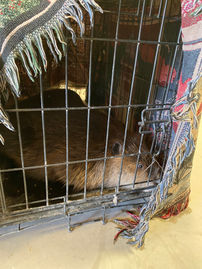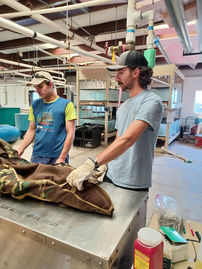Jens Ammon





Low-Tech Process-Based Riverscape Restoration
Anabranch Solutions Internship 2021
Over the summer of 2021, I worked with Anabranch Solutions to improve the overall health of riverscapes in Colorado, Idaho, and Utah. Our restoration work followed a Low-Tech Process-Based Restoration approach (LTPBR), meaning we used hand tools and local materials already present on site rather than bringing in large mechanical equipment. Our goal was to build key structures within the channel of the river that would then force natural processes to finish the restoration.

Who is Anabranch?
Anabranch Solutions (website here) was founded by a group of aquatic science professors at Utah State University to assist with the conservation and restoration of riverscapes across the Western United States. Anabranch works with federal and state organizations as well as private land owners to design, construct, and manage a restoration plan unique to each river.
How Does LTPBR Work?

Post-Assisted Log Structures, or PALS, are used to mimic and promote the process of wood accumulation in the river. We build a dense pile of wood that acts as a debris jam to redirect flow and catch further woody debris. Posts are then driven into the channel bottom and banks to pin down the structure so it doesn't float away during floods. The above PALS spans the entire river channel, but mid-channel and partial-channel PALS are also common to direct flow.

Beaver Dam Analogs, or BDAs, are used to mimic and promote the process of beaver dam activity. These structures are built with layers of leafy sticks and dirt, with the goal of backing up water and causing flooding. It is often necessary to mimic a beaver dam in order to promote a beaver to take over the area. Wooden posts are sometimes used to secure a BDA, but interwoven branches are usually sufficient to keep the structure in place.
Through a combination of these structures, a design plan specific to the river can be drafted. These designs aim to create a multi-channel, dynamic riverscape where possible, offering much more habitat space and ecological benefit than a single-channel, incised river. An example I created of such a design plan can be found here.
Why is This Important?

Degraded

Restored
Due to development, infrastructure, agriculture, and grazing, the vast majority of streams in the Western United States and elsewhere are in an incised, degraded state (The Disappearing West). Stream incision is generally connected with rapid land erosion, a deeper water table causing less riparian vegetation, streams running dry due to the rapid conveyance of water, and the ecosystem being less resistant to drought and fire overall. As such, restoration work is needed to bring these river back to a healthy state. The simple structures of a LTPBR approach are much cheaper and faster to implement than large engineering projects or mobilizing earth moving equipment. Since the structures used in LTPBR are designed to promote natural wood accumulation processes, the repair processes will over time become self-sustaining.
Why Beavers?
Beavers have historically been a major part of American riverscapes, but due to the beaver fur trade, populations in modern rivers are now drastically lower. Beaver dams can benefit riverscapes by:
-
Slowing water, catching sediment, and preventing rapid incision
-
Leaking water all season long instead of just a large spring runoff
-
Raising the water table and sub-irrigating the valley
-
Expanding the riparian area and creating habitat for fish and wildlife
Essentially, beavers do our job at Anabranch for us.
Project 1
Mountain Island Ranch
Colorado
Objective: Maintain water further into the dry season
Location: Little Dolores River
The Little Dolores River project was for the privately owned Mountain Island Ranch in Grand Mesa, Colorado. The land owner was concerned that the stream had been running dry early into the summer season for the past few years. Since Anabranch came in when the Little Dolores already had little to no water, the restoration plan relied heavily on PALS. In this scenario, the PALS are more effective because they are much quicker to build than BDAs and without water, careful construction of BDAs would be pointless. Also, the area had abundant downed cottonwood material near the river to facilitate construction.




With downed cottonwood and dead log material in close proximity around the river, many of the log structures in the Little Dolores River were able to be made without posts pinning them down. The logs used in the structures are heavy and interwoven enough that only a large flood will move them. These structures will trap further debris and sediment during the next wet season and aggrade the river out of its incised state.
Project 2
Sawtooth National Forest
Idaho
Objective: Prepare the area for beaver introduction
Location: Coal Pit Creek and McMullen Creek
The Sawtooth National Forest project was for Idaho Fish & Game office near Magic Valley, Idaho. Idaho Fish & Game was looking to release beaver into the Coal Pit Creek and the McMullen Creek within the forest boundary. Anabranch was contracted to assist with this process and prepare the streams to increase the likelihood that the released beavers will stay in those areas. This project relied heavily on postless BDAs in order to create ponds that the beavers can hide in and use when released. Difficult site access and rough roads made the postless option much more viable than trying to bring in heavy post pounding equipment and wooden posts.



Beaver dam analogs built along these creeks made pools ranging from knee deep to waist deep. Pools like this raise the water table in the area around the river, promoting the growth of riparian vegetation.
The above video shows a new river channel activated by the water backed up by the BDA.
Project 3
Basin Creek
Utah
Objective: Relocate nuisance beaver
Location: Basin Creek
The Basin Creek project was for a private land owner who had previous experience with Anabranch and wanted more beavers on the property. For this project I worked with the Beaver Ecology and Relocation Center of Utah State University. The beavers were trapped from privately owned land where the land owner was concerned the beaver would block a spring that was used to supply drinking water to the house. The trapped beavers were then assessed for health and marked with a PIT tag before being brought to Basin Creek. Similar to the objective in the Sawtooth National Forest, a few BDAs were built in Basin Creek on the day of release to give the beavers an initial habitat to avoid predators.
The beavers were trapped using box cages placed on what appeared to be well traveled paths near the beaver lodge. During transport, wet towels are placed over the cages to help regulate temperature and keep the beavers comfortable. During processing, adult beavers are placed into a cone-shaped canvas bag with a hole for their nose to prevent injury to the workers and beavers. Adult beavers will bite when they are stressed, but young beavers are not as defensive, which is why I was able to reach into the cage in the below video.




Once the beavers have been checked for injuries, sexed, PIT tagged, and quarantined for three days, they are ready to be released. Beavers tend to stay together in family groups, so all the beavers caught from one pond have to be released together.
For this project, the landowner had a few locations in mind for where he wanted the beavers. From those locations, we chose the best area for release based on the amount of in-stream vegetation cover and the proximity of woody vegetation that the beavers will use for food and building. A few BDAs were constructed to give the beavers a safe area as they adjust to their new home, and then the beavers were released.







